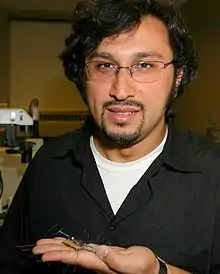Metin Sitti
Metin Sitti is the director of Physical Intelligence Department of the Max Planck Institute for Intelligent Systems in Stuttgart and an adjunct professor of Koc University School of Medicine. He obtained his PhD in Tokyo University. He is interested in micro/nanorobotics, nanomanufacturing, MEMS/NEMS, biomimetic micro/nanosystems, directed self-assembly, bionanotechnology, haptic interfaces, and tele-robotics. He conducted the Micromechanical Flying Insect Project.

Sitti is currently working on the development of robots using a "sticky" elastic polymer capable of adhering to a variety of surfaces, inspired by the "hairs" which allow geckos to stick to walls. According to the Pittsburgh Tribune-Review: "Sitti's most recent innovation is to use the gecko-inspired technology to print electronics on sticky surfaces. This way, circuit transistors can be woven into fabric and clothing."[1] New Scientist reported in an interview with Sitti that sticky robots using the gecko-hair technology could "tackle many jobs in the home including painting ceilings and clearing cobwebs. They could also play a part in exploration, inspection, repair and even search and rescue."[2]
Working with graduate student Yun Seong Song, Sitti also designed a tiny robot that, mimicking a water strider insect, can walk on water by utilizing the waters' surface tension.[3]
Sitti is also a distinguished service professor position in Department of Electrical Engineering and Robotics Institute in Carnegie Mellon University.[4]
References
- Puko, Tim (October 21, 2011). "Newsmaker: Metin Sitti - Pittsburgh Tribune-Review". pittsburghlive.com. Retrieved February 24, 2011.
- Marks, Paul (April 21, 2009). "Super-sticky robots to follow in gecko's footseps". New Scientist. Retrieved February 24, 2011.
- Zyga, Lisa (July 11, 2007). "Robot walks on water". physorg.com. Retrieved February 24, 2011.
- "Metin Sitti". engineering.cmu.edu. Retrieved 2020-06-12.